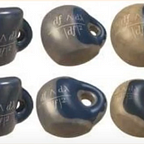Groups, rings and fields are mathematical objects that share a lot of things in common. You can always find a ring in a field, and you can always find a group in a ring.
A group is a set of symbols {…} with a law ✶ defined on it. Every symbol has an inverse 1/x , and a group has an identity symbol 1.
More formally, a group (G, ✶) satisfies following axioms:
- Closure: ✶ : G × G → G
- Associativity: (a ✶ b) ✶ c = a ✶ (b ✶ c), for any a, b, c ∈ G.
- Identity: There exists an element e in G, such that for all a ∈ G, a ✶ e = e ✶ a = a.
- Inverse: For any a ∈ G, there exist a unique a’ such that a ✶ a’ = a’ ✶ a = e.
A ring is a set of symbols {…} with two laws (+, x) defined on it. It does not need to have an identity 1, and not every symbol has an inverse 1/x.
A ring (R, +, ×) satisfies the following axioms:
- (R, +) is a commutative group
- Associativity: (a × b) × c = a × (b × c), for any a, b, c ∈ R.
- Distributivity: (a + b) × c = a × c + b × c.
Notice that since R under addition (R, +) is already a group, it contains an additive identity 0, and every element a in R contains an additive inverse: - a. However, R under multiplication (R, x) is not a group, it does not need to contain a multiplicative identity 1 (e.g., the ring 2Z), nor does any element a in R need to have a multiplicative inverse a’.
An abelian (commutative) group satisfies all the axioms of a group, plus commutativity: a ✶ b = b ✶ a, as is the case with addition (+).
A field is a set of symbols {…} with two laws (+, x) defined on it, such that each law forms a group.
A field (F, +, ×) satisfies the following axioms:
- (F, ×) is a commutative ring.
- Identity: There exists a multiplicative identity 1 in F such that a × 1= 1 × a = a, for all a ∈ F.
- Inverse: For any a ∈ F - {0}, there exists a unique multiplicative inverse 1/a such that a × 1/a = 1/a × a = 1.
Notice that a field is automatically a ring. Because 0 does not have a multiplicative inverse, 2 and 3 could be summarized as: (F - {0}, ×) is an abelian group.
